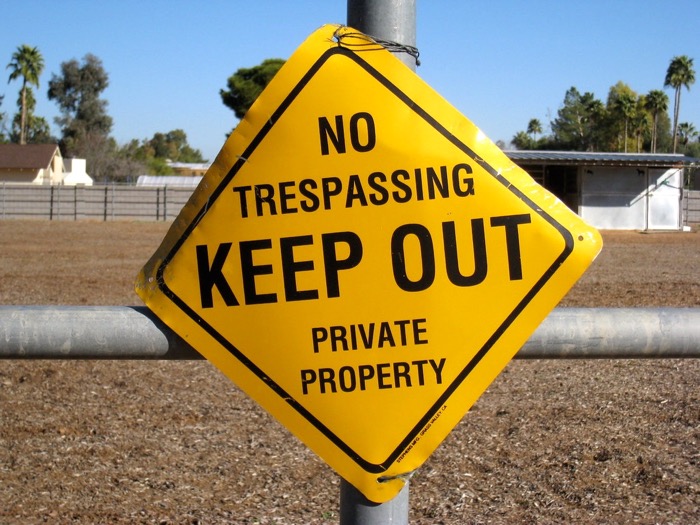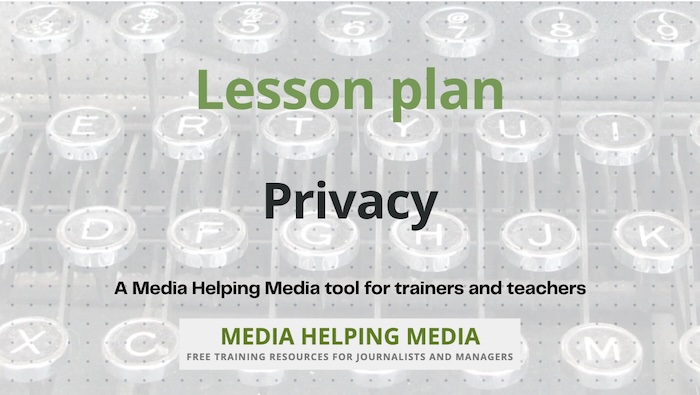
Journalists face a difficult balancing act. They must respect privacy, but they must also be rigorous and robust in their investigations into issues that are in the public interest.
This means that in some cases it will be necessary for a journalist to carry out an investigation that interferes with someone’s privacy.
Such cases could include:
- crime and anti-social behaviour
- corruption or injustice
- incompetence or neglect
The most important rule is that we must treat people fairly and with respect. We must also be clear about our own motives. We must have no personal interest in an investigation that invades a person’s privacy. The only justification is that it is in the public interest and we are genuinely trying to expose wrongdoing.
What does privacy cover?
Privacy covers anything that a person might reasonably expect to keep from becoming public knowledge. It could include some facts that are known by some, but not by all. There will also be cases where a person in the public eye, who is in a public place, can expect to have their privacy protected. Such cases might be where they are in a clinic or hospital receiving treatment.
Submitted material
Increasingly, journalists are using user-generated content (UGC). This is where members of the public record video, sound or still images and either share them with media organisations, or on social media where the journalist can download and reuse the material.
This does not mean that journalists can ignore their editorial principles, and it raises important editorial issues.
For example, if material is in the public domain and everyone is talking about it yet we ignore it, we might be seen as missing out on an important element of a news story and failing to inform our users. Such situations need careful editorial consideration.
Care needs to be taken with submitted material, particularly that taken from security cameras, webcams, video cameras and mobile phones.
It’s unlikely that we will be able to verify all contributed material as being genuine. Many respected news organisations stipulate that material has to be verified by two independent sources. This might not be possible with contributed material. In that case, an editorial decision needs to be made about whether to use the material or not.
Clear labelling is a way around this if we feel that the material is justified, but we need to be careful about displaying material that could compromise our editorial values and those of the news organisation we work for.
Reliability, trust, honesty, fairness and accuracy are hard-won values and we must protect these. If your audience sees material that leads them to believe that you have moved away from such values, you might lose their trust.
Judge and jury
A journalist’s job is to report facts and inform the public debate so that people can make educated choices. We are not the judge and jury regarding what is right and wrong in the communities we serve.
Journalists have a right, and a duty, to investigate stories in the public interest, but they must not consider themselves to be beyond the law. They must also consider the hurt and damage that their digging might cause.
Some feel that an individual’s right to privacy is qualified by their behaviour. If a person is considered to be involved in crime or anti-social behaviour, it could be felt that they have given up their right to privacy because it is more likely to be in the public interest to expose their behaviour. This is not for us to decide.
This is also a delicate area. Events that might be termed by some to be anti-social or unlawful behaviour could, in some cases, be seen by others as an important and legitimate protest against unjust regimes and systems.
If we are asked to stop recording, taking photographs or jotting down notes because of concerns about privacy, we should do so unless it is editorially justified to continue. At that point we need to be absolutely clear about our reasons.
Keeping up with our competition, winning more viewers, or selling more papers are not good enough reasons. The story must inform the public debate and it must be an accurate and fair representation of the known facts.
Even then, the journalist must be sure that they have come to a considered conclusion having weighed all the facts.
Obtaining consent
There are a number of places where journalists should obtain two forms of consent, one to gather the material and the other to broadcast or publish it. These include hospitals, schools or prisons. Journalists should always seek permission from their seniors:
- to use unattended recording equipment without the knowledge of those being recorded
- to record telephone conversations originally intended for background information
- to door-step a potential interviewee without making a prior approach
- to broadcast material recorded by others, such as UGC.
Secret recording
If a journalist intends to make a secret recording, they have to be able to justify the decision on the grounds of there being a clear public interest.
It is sometimes justified if it is likely to gather evidence or behaviour that the audience would otherwise not see and hear. Justifications for secret recordings could include:
- where there is evidence that there is an intention to commit an offence
- where an open approach would be unlikely to succeed
- gathering evidence
- consumer, social or scientific research in the public interest.
In all cases, the material gathered should be a fair and accurate representation of what has happened. There is also an obligation on the journalist to seek retrospective consent and, in some cases, obscure some identities. Secret recording could include:
- the use of hidden cameras and microphones
- long-range audio-video equipment
- small video cameras
- the use of drone cameras
- mobile phone cameras
- concealed radio microphones
- phone calls
- continuing to record after the interview is over.
If you are intending to carry out a secret recording, make sure that your editor has approved it. Your news organisation will have a procedure. Ensure that you comply. It will probably involve:
- senior editorial approval and signed documents
- a clear declaration as to why the action is in the public interest
- a statement as to how the material is to be used
- an accurate log of what has taken place
- a certificate or licence if legally required
- a log of what is to be broadcast and what will not be broadcast
- an honest declaration of any deception that was required to gather the material.
That final point is extremely important. Journalists are increasingly coming under pressure not to use editing or newsgathering techniques that could be seen as misleading.
If you intend to use any material gathered secretly in the future – such as in a review of the year or referring to a story when following up the item – you will probably have to revisit the whole process, but legal advice will need to be taken.
You will need to be certain that all you propose to do is in the public interest, particularly in:
- a private place where the public does not have access
- where people are receiving medical treatment
- in cases of grief and extreme stress.
It is never justified to go on so-called fishing expeditions where secret recording is carried out on private property in search of crime or anti-social behaviour.
Similarly, you should never leave recording equipment on private property with the intention of gaining evidence of serious crime unless you have first obtained senior editorial sign-off and can justify your actions in terms of public interest.
Electronic note-taking
Many reporters use electronic equipment as part of their note-taking. Some use recorders instead of notebooks, believing it to be a better way of ensuring accuracy in their reporting.
It needs to be made clear at all times that such electronic note-taking is for research and not for broadcast. If you find you have stumbled upon a significant newsworthy clip that is clearly in the public interest to broadcast or publish you will need to discuss this with senior editors and apply the public interest test.
Door-stepping
Sometimes a reporter must be persistent in order to secure an interview. Is it really necessary? What purpose does it serve? What information is likely to be gathered that is not available through other, more conventional, channels?
A journalist has a duty to continue to question their own motives and the value of what they are doing. The general public can expect a certain amount of protection from door-stepping, however public figures, particularly politicians, fall into a different category. They expect questions being thrown at them without prior arrangement and should expect the answers to be published.
If you are convinced that the story you are chasing is in the public interest, you might want to door-step because the person involved has failed to respond to repeated interview requests. But they have a right to refuse. You also have the right to tell the public that this person refused an interview.
Tag-along scenario
A tag-along scenario is when a journalist accompanies officials carrying out their work in order to cover a story that is in the public interest. This could include going along as an observer with police, customs, immigration, or environmental health officers or other public authorities on operational duties.
But you have to be absolutely certain that there is a clear public interest, because this touches on many issues such as privacy, consent and trespass.
If you do tag along on an official visit to a private property, you must make it clear for whom you are reporting and where the material will be used, seek consent from the occupier of the property being raided, and be prepared to leave immediately if consent is refused – unless it has been agreed with your senior editors that there is a clear public interest in the event being covered.
Reporting suffering and distress
The media’s relationship with the public during times of suffering and distress is unpredictable. Journalists may often be sent out to the home of someone who has lost a loved one through criminal activity, an accident, or a bombing. There are a few common reactions.
The first is when you knock at the door and nobody answers, although you can see that there are lights on and you can hear voices. You know that people are in and you know that they don’t want to be disturbed. However, you also know that your news editor is expecting an interview with the relatives of the deceased and a picture of the person who has died.
What do you do? Do you keep knocking until they answer, or give up and head back to the office, respecting their grief and their decision to hide from you? Your news editor will either be totally supportive or will give you a hard time for not getting the interview and picture. You could write a note and put it through the door telling them why you called and why you wanted to talk to them.
The second reaction is that they open the door and set the dogs on you or give you a mouthful of abuse.
The third is that they invite you in, put the kettle on, make a cup of tea, and then show you all their family photographs and let you take some away.
You never know which reaction you will get. It is important that the reporter is sensitive to the suffering people are going through.
Intruding on private grief can hardly be in the public interest. However, here is the contradiction; the media often get criticised for covering grief, but people buy newspapers and turn on their TV expecting to see pictures of those who have died through tragic circumstances.
We can’t win, but we can be professional, consistent, and ensure that all we do is in the public interest.
Graphic material
We always need to consider carefully the editorial justification for portraying graphic material of human suffering and distress. There are no circumstances in which it is justified to show executions, and very few circumstances in which it is justified to broadcast other scenes in which people are being killed. We should also avoid the gratuitous use of close-ups of faces and serious injuries or other violent material.
We must also be global in our news values. If we have editorial rules that state that we don’t publish details of someone who has been killed until the family has been notified, then that rule has to be applied globally. Those in the West who apply such rules to domestic coverage need to ensure that they are consistent when dealing with tragedies in far-flung countries.
The family of a dead person – who can clearly be identified from still pictures or footage – but who is the victim of a killing thousands of miles away, is entitled to the same editorial standards we apply when the incident is on our doorstep.
The passage of time is an important factor when it comes to making judgements about broadcasting graphic material. In the immediate aftermath of an event, the use of more graphic material is normally justified to provide a reasonable illustration of the full horror, although a good script is equally important in conveying the reality of the tragedy.
However, as the story unfolds it may become more difficult to justify its continued use. When it comes to marking the anniversary of an event or when considering it in a contemporary historical context, it may again be editorially justified to re-use it.
We must not add to a person’s suffering and grief. We should not put them under any pressure in order to obtain an interview. We must not harass them with repeated phone calls, emails, text messages or calls at their door, we must not ignore their pleas for us to leave, and we should not follow them if they are trying to avoid/escape us.
Graphic scenes of grief are unlikely to offend or distress those victims and relatives who consented to our recording them, but we need to remember that the images could upset or anger members of the audience. It helps if we set out the context for the images people are about to see in order to prepare them and to help prevent any misunderstandings.
Funerals
Funerals, except in the case of public figures, are usually considered a private affair. We should not attend without the consent of the family. Even in the case of people in the public eye, such as politicians, entertainers and sports personalities, we should also respect a family’s wish to have a private funeral. In such cases there is usually a public event to which the media is invited and often a private event for family only.
Revisiting past events
Responsible media organisations will frequently return to past events in order to put current events in context. As a result, journalists need to ensure that they do all they can to minimise any possible distress to the surviving victims and relatives.
This is particularly important when covering suffering and trauma. This also applies even when material being published or broadcast was previously in the public domain. Where possible, surviving victims or the immediate families of the dead people who are to feature in the programme should be notified in advance.
Archive material
All news organisations use archive material in news coverage. This will include the reuse of scenes of suffering, distress and trauma. We have a duty to ensure that the repeated use of such material, particularly where it features people who can be identified and are still alive, is editorially justified.
We should never use such material to illustrate a general theme. At all times we must be sensitive to the impact such material is likely to have on those who suffered the first time round.
Missing people
The media is often called on to help trace people by broadcasting details of missing people which has been provided by relatives and friends.
We must not give over our journalism to the control of others. It could be that information the family is keen to release could be embarrassing and distressing. It could be that the information is infringing the missing person’s privacy.
We must always take editorial responsibility and consider whether the missing person would want the information published if they are found. We should also respect the fact that not every missing person wishes to be found.
Personal information
A journalist has a responsibility to be totally open and transparent with people about how they intend to use their personal information. This includes details such as telephone numbers and email addresses. We must never pass these on to others without obtaining the owner’s consent.
 Questions
Questions
- What is the primary challenge journalists face when balancing privacy and public interest in their investigations?
- Define “privacy”. What are some examples of situations where privacy might be expected?
- Explain the role of user-generated content (UGC) in journalism and the editorial challenges it presents.
- Why is it important for journalists to verify contributed material, and what are some methods mentioned for verification?
- Discuss the ethical considerations journalists must weigh when deciding to use secret recordings.
- What are the guidelines for journalists when obtaining consent in sensitive locations such as hospitals or schools?
- How should journalists handle situations where they are asked to stop recording due to privacy concerns?
- Analyse the potential consequences for a journalist who fails to maintain reliability, trust, honesty, fairness, and accuracy in their reporting.
- Evaluate the ethical implications of door-stepping in journalism. When might it be justified?
- Sum up the considerations a journalist must take into account when reporting on suffering and distress. How can they balance public interest with respect for individuals’ privacy?
Answers
- Journalists must balance respecting individuals’ privacy with conducting thorough investigations into matters of public interest, which may sometimes require privacy intrusion.
- Privacy covers anything a person might reasonably expect to keep private, such as personal facts not widely known. Examples include being in a clinic or hospital receiving treatment.
- UGC involves the public sharing media with journalists, raising issues of editorial integrity and the need to verify the authenticity of such content.
- Verification is crucial to maintain credibility. Methods include requiring confirmation from two independent sources, though this may not always be possible with UGC.
- Secret recordings must be justified by a clear public interest, such as gathering evidence of wrongdoing that would otherwise remain hidden.
- Journalists should obtain consent to gather and publish material in sensitive locations, and seek permission from senior editors for certain actions.
- Journalists should stop recording unless there is a strong editorial justification to continue, ensuring they are clear about their reasons.
- Failing to uphold these values can lead to a loss of audience trust and damage the journalist’s and their organisation’s reputation.
- Door-stepping may be justified if the story is in the public interest and other methods have failed, but the person involved has the right to refuse an interview.
- Journalists must be sensitive to individuals’ suffering, ensuring their reporting is in the public interest without adding to the distress of those involved.
Lesson plan for trainers
If you are a trainer of journalists we have a Lesson plan: Respecting privacy as a journalist which you are welcome to download and adapt for your own purposes.
The free teaching tools at the Khan Academy were used as a basis for converting the original article into a lesson plan.









